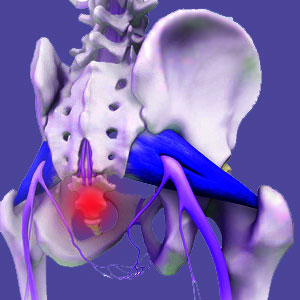
Coccyx pain, also called coccydynia, can become a chronic problem for many patients. The tailbone seems like a useless structure and when it becomes the source of persistent suffering, patients can’t help but question why they have a coccyx at all, since it serves no apparent purpose in the modern human anatomy. Tailbone pain is usually not a debilitating problem, but is more of an annoying and ongoing suffering that prevents patients from being able to sit comfortably. Coccydynia is known to be a long-term concern for many people, especially those who develop pain without a known injurious cause.
This focused essay examines the causes and symptoms of coccyx-related pain. We will also discuss the most effective treatment strategies using both conservative and surgical methods of care to bring about relief.
Coccyx Pain Symptoms
Coccyx pain is located in the center line of the buttocks anatomy, usually somewhere within the intergluteal cleft. The pain is often absent when the patient is upright or active, but comes on when the patient sits down, particularly on a hard surface. A minority of patients have pain when they recline on their backs, stand or perform physical activity.
Coccyx pain is usually dull, achy and progressively worse as the patient remains seated. In some instances, pain can be sharp and similar to the sensation of electric shocks. A majority of patients also suffer tingling and sore numbness in the tailbone region, in association with pain and often persisting once the pain has decreased.
Very few patients cite pain that is related to general spinal movement, such as bending or lifting. However, virtually all coccydynia patients report that impact activities result in escalated symptoms. More than 65% of patients report that voiding their bowels is also a symptomatic exacerbating factor. About the same number report that sexual activity causes worsened pain and a fair number avoid sex completely in order to prevent what they describe as their worst symptoms. Finally, the coccyx actually changes in women during pregnancy and birth. Many women report coccyx discomfort prior to, or after, giving birth and some will develop chronic symptoms that endure long past the expected time of resolution.
Causes of Coccyx Symptoms
The coccyx is a mysterious evolutionary remnant. It is all that is left of the vestigial tail demonstrated by our ancient ancestors. The coccyx serves no known purpose in the modern human anatomy, except to become a potential source of pain.
A large number of patients with chronic coccyx symptoms report injuring their tailbone at some point. Since the coccyx is actually segmented naturally, it is highly susceptible to fracture and in these circumstances can cause acute pain. If the fracture does not heal correctly, or heals in such a manner to create mechanical or neurological dysfunction, then chronic pain can result. Common sources of coccyx injury include rearward falls landing on the buttocks, sporting injuries, acts of violence and any type of major impact. The most widely reported specific types of injury leading to coccyx trauma include slipping in the bathtub or falling on ice.
Some people simply have a particularly prominent tailbone and these people are statistically more susceptible to coccyx pain, as well. Even if there is no pathology demonstrated by the prominence, the fact that the structure “sticks out” of the intergluteal cleft more than usual seems to make it more prone to pain from pressure, such as when sitting.
A significant portion of patients with tailbone pain are classified as suffering from idiopathic causation. These people have never injured their coccyx, nor demonstrate any abnormality in the structure. Regardless, they suffer dramatic pain that often exceeds patients who have known reasons to explain their symptomology. A great number of these patients are suffering from a psychogenic origin, as proven by the effectiveness of mindbody therapies in many studies. Others might demonstrate soft tissue pathologies that are not diagnosed, but still affect the way the coccyx is positioned within the lower spinal anatomy.
Coccyx Pain Treatment
There are many possible causes of coccyx pain, so the best form of treatment varies according to origin. Fractures can usually be resolved using closed or open reduction practices. Sitting-related pain can often be managed using activity avoidance, special seat cushions and mindbody therapies. Pregnancy-related tailbone pain might be resolved using special exercises that are known to help reduce symptoms in about half of affected patients.
Idiopathic coccyx pain fares the worst statistically. Patients are usually treated with pharmaceutical therapy, at great risk to their overall wellness. Some will receive physical therapy, but few will respond positively. For patients with severe and lasting pain, the solution will usually come in the form of coccyx removal surgery, known medically as coccygectomy. Although the technique is invasive and demonstrates some risks, it is known for being mostly effective for curing idiopathic tailbone pain patients and those with known, but treatment-resistant, causes of symptoms.
We warn patient to exhaust nonsurgical and mindbody therapies before undergoing surgery. A significant number of postoperative patients still report phantom coccyx pain even once the structure has been removed from their anatomy. This is a sure indicator of a larger mindbody pain syndrome at work. These patients would have been much better served by the application of knowledge therapy, rather than cruel and unnecessary surgery.
Lower Back Pain > Lumbar Back Pain > Coccyx Pain





